This ribeye steak recipe delivers restaurant-quality flavor at home, complete with a tart cherry balsamic sauce! Whether cooking on the grill or in a skillet, the key is salting ahead of time and cooking with plenty of garlic, herbs, and butter. Read on for tips and tricks for the juiciest steak every time—even if you’ve never cooked ribeye before!
This post is sponsored by the Cherry Marketing Institute. All opinions are my own.


This is the Best Way to Cook Ribeye Steak
Ready to become a ribeye master? I’ve researched, experimented, and taste-tested different cooking techniques side-by-side to bring you the perfectly seared, buttery, and flavorful steak of your dreams.
THE KEY TAKEAWAYS


Ribeye RECIPE Ingredients
Let’s take a closer look at what you need to make this ribeye steak recipe (measurements in the printable recipe card at the bottom of the post):

HOW TO SELECT RIBEYE STEAKS
By selecting a well-marbled, thick-cut ribeye, you’ll have the perfect steak for a beautifully seared crust and a tender, juicy interior. Here’s what to look for:
1. Boneless or Bone-In: This recipe is for boneless ribeye steaks, which are easier to cook evenly in a pan. If you use bone-in, I recommend a hybrid stove-to-oven method.
2. Thickness: Opt for a steak at least one inch thick (up to two) and even cut—mine were about 2 inches in the photos. Thicker steaks are easier to cook evenly and less likely to overcook during searing.
3. Marbling: Look for abundant marbling (white streaks of fat throughout the meat). This fat melts during cooking, keeping the steak juicy and flavorful.
4. Color and Freshness: Choose steaks with a vibrant red color and avoid ones that look dull or grayish. The fat should be creamy white; yellowish fat can indicate older meat.
5. Grade: Steak is graded by its tenderness, juiciness, and flavor quality. For the best results, look for USDA grades like Prime (highest marbling and quality) or Choice (good marbling and quality).


For the tart Cherry balsamic sauce
Montmorency tart cherries are the star of the stunning sweet-tart sauce! It’s made with aromatic shallots, thyme, and one 15-ounce can of tart cherries, with hints of balsamic, vinegar, honey, and Dijon.
•Montmorency tart cherries are the most common variety of tart cherries grown in the U.S. They are picked at peak freshness and made available year-round in dried, juice, canned, and frozen forms (they aren’t typically eaten fresh).
•You can find cans of tart cherries, also known as sour cherries, in water-packed cans at your grocery store or on Amazon. The cherries are fabulous in sweet and savory applications, such as cherry pie, pastries, cakes, etc.!
•They are a superfruit! Research suggests they may help exercise recovery, heart health, sleep, arthritis, and gout.
•American-farmed Montmorency tart cherries are primarily grown in Michigan, Utah, and Wisconsin and shipped directly to your grocery store. Imported tart cherries may travel more than 5,000 miles before reaching your town!

Ribeye Steak Recipe Variations
STEAK SEASONING IDEAS

How to Cook Ribeye Steak
Ribeye steak is best cooked using high-heat methods like grilling, pan-searing, or a hybrid stove-to-oven method to achieve a beautifully caramelized crust while keeping the interior tender and juicy. Let’s take a look at each method (full recipe in the printable recipe card at the bottom of the post):
Prep

How to cook ribeye steak on the stove
Cooking a ribeye on the stove is my preferred method because it offers maximum flavor development through garlic and herb-infused basting butter, a deeply caramelized crust, and control over the cooking process.
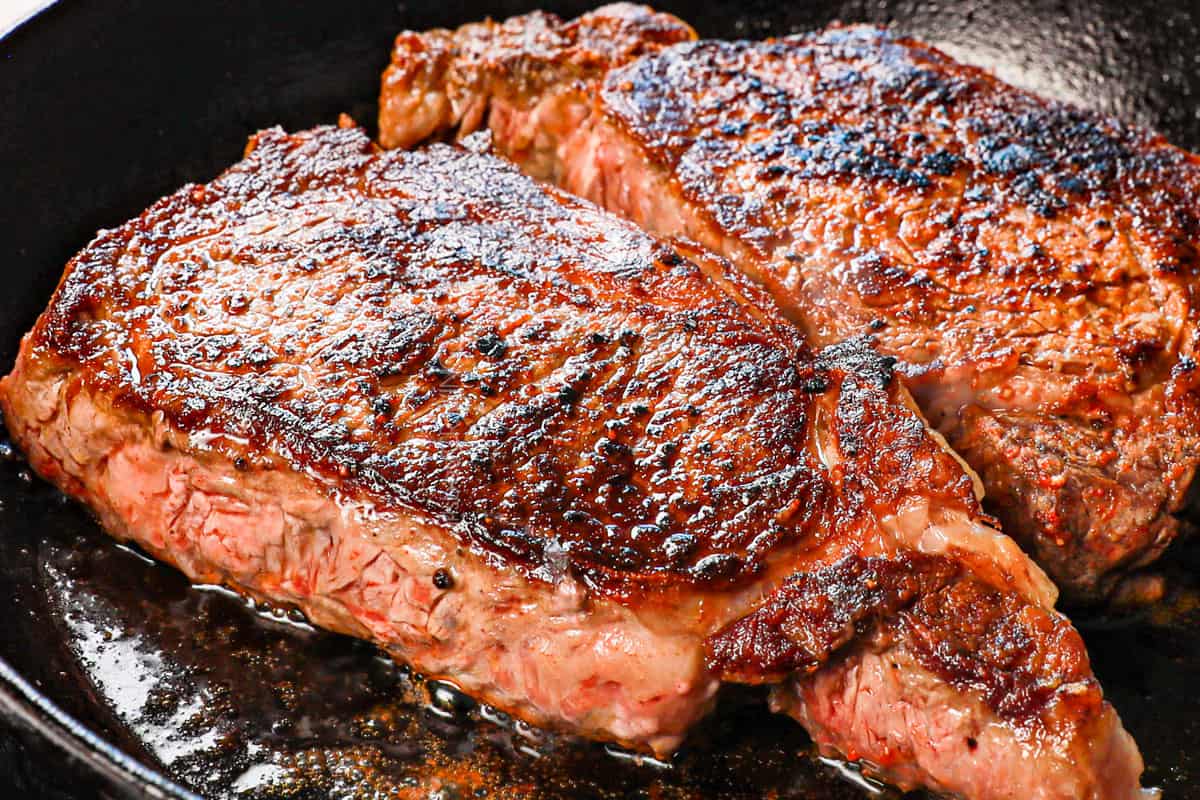


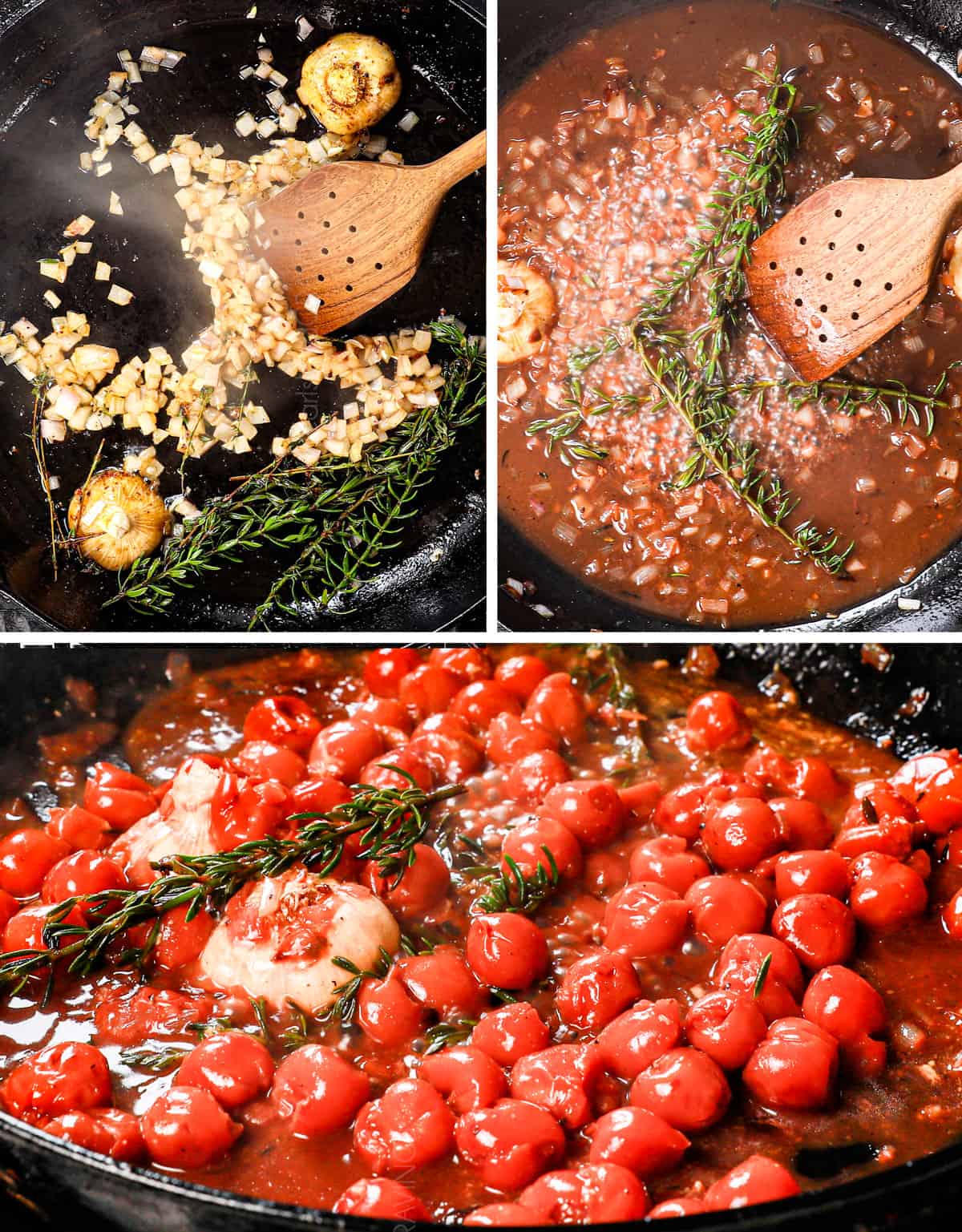

How to grill ribeye steaks
1. Season: Season the steaks per the recipe card below at least 60 minutes before or immediately before grilling. Rest at room temperature for 60 minutes.
2. Preheat the Grill: Heat the grill to high heat (450–500°F). Clean and oil the grates with vegetable or canola oil to prevent sticking.
3. Sear the Steaks: Sear for 3–5 minutes per side with the lid closed (Always check early!). Don’t move them to allow for a proper crust.
4. Adjust Heat and Finish Cooking: For thicker steaks, move them to a cooler part of the grill to finish cooking over indirect heat until they reach your desired internal temperature:
5. Rest: Remove the steaks from the grill and let them rest for 10 minutes to allow the juices to redistribute.
How to cook ribeye steak in the oven
1. Season: Season the steaks per the recipe card below at least 60 minutes before or immediately before grilling. Rest at room temperature for 60 minutes.
2. Heat the Skillet: Heat a cast iron pan over high heat. Add the vegetable oil and swirl so it coats the pan.
3. Sear Steak: When it starts to smoke, add the steaks and sear for 2 minutes per side, or until a deep golden-brown crust forms.
4. Add Aromatics: Add a halved head of garlic (cut side down), fresh herbs (like rosemary or thyme) to the pan, and a thick pad of butter on top of each steak and in the pan.
5. Roast: Transfer the pan to the preheated oven to finish cooking to your preferred temperature. Depending on thickness and desired doneness, this typically takes 3–7 minutes.
6. Rest: Transfer the steaks to a cutting board and let them rest for 10 minutes to allow the juices to redistribute.


How long to cook a ribeye steak
The cooking time for a ribeye steak depends on its thickness, your cooking method, and your desired level of doneness (See Chart Below). You may need to reduce the heat and cook slightly longer for thicker cuts or higher doneness levels.
HOWEVER, I don’t recommend grilling steaks according to time—grill according to temperature. Always use a meat thermometer to check doneness and let the steak rest for 10 minutes after cooking to allow it to rise an additional 5 degrees and for the juices to redistribute.
| Doneness | Stove Time | Grill Time |
| Rare (125°F) | 2–3 minutes per side | 4–5 minutes per side |
| Medium-Rare (130–135°F) | 3–4 minutes per side | 5–6 minutes per side |
| Medium (135–145°F) | 4–5 minutes per side | 6–7 minutes per side |
| Medium-Well (145–155°F): | 5–6 minutes per side | 7–8 minutes per side |

Tips for the Best Ribeye Steak Recipe
Prep

COOKING

How to serve this Ribeye Recipe
Serve this ribeye recipe alongside classic steakhouse sides like mashed potatoes, roasted vegetables, and a fresh salad. Here are some of our favs:

How to store a Ribeye Steak
To store cooked ribeye steak:
•Refrigeration (Short-term): Allow the steak to cool to room temperature, then wrap it tightly in plastic wrap or place it in an airtight container. Store it in the refrigerator for up to 3–4 days.
•Freezing (Long-term): Wrap it tightly in plastic wrap, followed by aluminum foil, or place it in a vacuum-sealed bag. Label the package with the date and freeze for 2–3 months.
•Reheating: When ready to eat, gently reheat the steak in the oven with a pad of butter on top or at a low temperature (250°F) to preserve its moisture, or use a skillet on low heat. Avoid microwaving directly to prevent the steak from becoming tough.
Ribeye Recipe FAQs
Ribeye steak is best cooked using high-heat methods like grilling or pan-searing to achieve a beautifully caramelized crust while keeping the interior tender and juicy. For optimal results:
•Preparation: Bring the steak to room temperature, pat it dry, and season generously with salt and pepper or your preferred rub.
•Cooking: Use a hot cast-iron skillet or grill. Sear the steak for 2–3 minutes per side to develop a crust, then lower the heat to finish cooking to your desired doneness (internal temperature: 125°F/52°C for rare, 135°F/57°C for medium-rare).
•Resting: Let the steak rest for 5–10 minutes after cooking to allow the juices to redistribute before slicing.
This method ensures a perfect balance of rich flavor and tenderness.
Cooking a ribeye on the stove is often preferred because it offers maximum flavor development and control over the cooking process. Here’s why it’s better in some cases:
•Better Crust Formation: The direct high heat from a skillet creates an exceptional Maillard reaction, resulting in a flavorful, caramelized crust that’s harder to achieve in the oven alone.
•Enhanced Flavor: On the stove, you can incorporate butter basting with aromatics like garlic and herbs, allowing the steak to absorb rich, nuanced flavors while cooking.
•Precise Control: The stove lets you adjust the heat instantly, giving you greater control over the cooking process to achieve your preferred doneness with precision.
•Speed: Stove-top cooking is typically faster than oven-roasting, making it ideal for when you want to enjoy your steak quickly without compromising on quality.
•Dynamic Interaction: You can monitor and interact with the steak, flipping and basting as needed to ensure consistent cooking and flavor.
For ribeyes, the stovetop method excels when you’re after a boldly seared crust and a juicy, flavorful interior.
Best of Both: Stove-to-Oven
This method can be effective for extra thick ribeye steak. This hybrid approach combines the strengths of both methods for a steak with a flavorful crust and a tender, evenly cooked center. However, I still prefer the stovetop method, even for thicker steaks.
To cook a ribeye steak so it’s not tough, follow these tips to maximize tenderness and juiciness:
1. Choose a Good Cut: Select a ribeye with good marbling (fat evenly distributed throughout the meat) as it melts during cooking and keeps the steak tender.
2. Bring to Room Temperature: Allow the steak to sit out for 30–60 minutes before cooking to ensure even cooking.
3. Season Generously: Salt the steak liberally at least 30 minutes before cooking (or overnight for dry brining) to break down proteins and enhance tenderness.
4. Use High Heat for Searing: Preheat a skillet or grill until very hot to quickly sear the outside, locking in the juices.
5. Cook to the Right Temperature: Use a meat thermometer to avoid overcooking:
Rare: 120°F–125°F (49°C–52°C)
Medium-rare: 130°F–135°F (54°C–57°C)
Medium: 140°F–145°F (60°C–63°C)
Pull the steak 5°F (2°C) below your target temperature as it will continue to cook while resting.
6. Rest the Steak: Let the steak rest for 5–10 minutes after cooking to allow the juices to redistribute and keep the meat tender.
7. Slice Against the Grain: When serving, slice the steak against the grain (the direction of the muscle fibers) to make each bite more tender.
By controlling heat, monitoring doneness, and resting the steak properly, you can enjoy a tender, juicy, and full-flavored ribeye.
Ribeye steak is best cooked fast using high-heat methods like pan-searing, grilling, or broiling. Here’s why:
WHY FAST COOKING WORKS:
•Caramelized Crust: High heat quickly develops a flavorful, golden-brown crust through the Maillard reaction, enhancing the steak’s taste.
•Preserves Juiciness: Rapid cooking prevents the steak from drying out by keeping the juices locked inside.
•Utilizes Fat: Ribeye’s marbling (intramuscular fat) melts during high-heat cooking, basting the steak from within and adding richness.
WHEN TO USE SLOW COOKING:
If cooking a bone-in ribeye or an extra-thick cut (over 1.5 inches), a hybrid fast-and-slow approach works best:
•First sear the steak on each side, then reduce the heat to medium or medium-low to continue to cook.
•This method ensures even cooking throughout while still achieving a crusty exterior.
What’s the best way to achieve a good sear on a ribeye steak?
To achieve a perfect sear on a ribeye steak, focus on high heat, a dry surface, and a hot cooking surface. Here’s the step-by-step guide:
1. Dry the Steak: Pat the steak dry with paper towels to remove surface moisture. A dry surface helps the steak caramelize better.
2. Season Generously: Season with salt and pepper (or your favorite rub) just before cooking or up to 30 minutes in advance for a dry brine.
3. Preheat Your Pan: Use a cast-iron skillet or heavy stainless steel pan for even heat distribution. Heat the pan over high heat until it’s very hot. You should see a slight shimmer or feel intense heat when you hover your hand a few inches above.
4. Use High-Smoke-Point Oil: Add a small amount of oil with a high smoke point, like vegetable, avocado oil, canola oil, or grapeseed oil. Heat until the oil just starts to smoke.
5. Sear the Steak: Place the ribeye in the pan and press it down slightly to ensure full contact. Sear for 2–3 minutes per side without moving it. This allows a deep, golden-brown crust to form.
Salting steaks and letting them brine in the fridge beforehand (a technique called dry brining) significantly enhances their flavor, texture, and juiciness. If you have more than an hour, it’s recommended, otherwise, add the salt just before cooking.
BENEFITS OF DRY BRINING
1. Enhances Flavor: Salt penetrates deep into the meat, seasoning it throughout rather than just on the surface. This creates a more flavorful steak.
2. Improves Texture: Salt breaks down muscle proteins, which makes the meat more tender as it rests.
3. Retains Juiciness: Initially, salt draws moisture to the surface of the steak. Over time, that moisture mixes with the salt and reabsorbs into the meat, creating a self-basting effect. This helps the steak retain more juices during cooking.
4. Promotes a Better Sear: Letting the steak rest uncovered in the fridge dries out the surface, which is essential for achieving a deep, caramelized crust when you cook it.
HOW TO DRY BRINE:
1. Generously salt the steak on both sides (use kosher salt for even distribution). Optionally, add other seasonings like pepper or garlic powder, but keep it simple for the best crust.
2. Place the steak on a wire rack set over a baking sheet to allow airflow around the meat.
3. Refrigerate uncovered for at least 1–2 hours, or up to 24 hours for maximum effect.
When you cook a dry-brined steak, you’ll notice a richer flavor, better texture, and a steakhouse-quality crust!
You generally shouldn’t marinate ribeye steak because it is a naturally flavorful and tender cut, thanks to its rich marbling and beefy taste.
WHY YOU SHOULD SKIP MARINATING RIBYE:
•Naturally Flavorful: Ribeye has excellent marbling and a rich, beefy flavor, so it doesn’t need extra enhancement.
•Risk of Over-tenderizing: Acidic marinades can break down the meat fibers too much, making a tender cut like ribeye mushy if left too long.
•Affects the Crust: Marinades add moisture to the surface, which can prevent the steak from forming a perfect seared crust.
Instead, simple seasoning with salt and pepper or a dry brine enhances the steak’s natural flavor without altering its texture or compromising the searing process.
A ribeye steak is considered one of the best cuts of beef due to its exceptional balance of tenderness, flavor, and marbling.
•Juicy and Flavorful: The cut comes from the rib section, which provides ample intramuscular fat (marbling) that melts during cooking, infusing the steak with rich, juiciness and bold, beefy flavor.
•Tender: This marbling makes ribeye steaks incredibly tender and moist, even when cooked to higher levels of doneness.
•Crust: Its ability to develop a beautifully seared crust, makes ribeye a favorite among steak lovers.
Versatile: It can be grilled, pan-seared, or broiled, making it ideal for various cooking methods.
Here are some popular ribeye steak variations:
•Bone-In Ribeye (Tomahawk): The ribeye with the bone left in, often with a longer bone, creating a dramatic presentation and additional flavor due to the bone.
•Boneless Ribeye: A more practical cut with the bone removed, offering the same rich flavor and tenderness but easier to handle and cook.
•Grass-Fed Ribeye: Ribeye from cattle raised on a grass diet, offering a leaner texture and a slightly more earthy flavor compared to grain-fed beef.
•Wagyu Ribeye: A luxurious cut from Japanese Wagyu beef, known for its exceptional marbling and buttery tenderness.
•Ribeye Cap (Spinalis Dorsi): The highly prized, tender, flavorful outer edge of the ribeye, often cooked separately or as a special cut.
•Aged Ribeye (Dry-Aged or Wet-Aged): Ribeye steaks that have been aged to enhance flavor and tenderness, with dry-aging imparting a more intense, beefy flavor.
These variations cater to different preferences for flavor intensity, tenderness, and cooking methods.
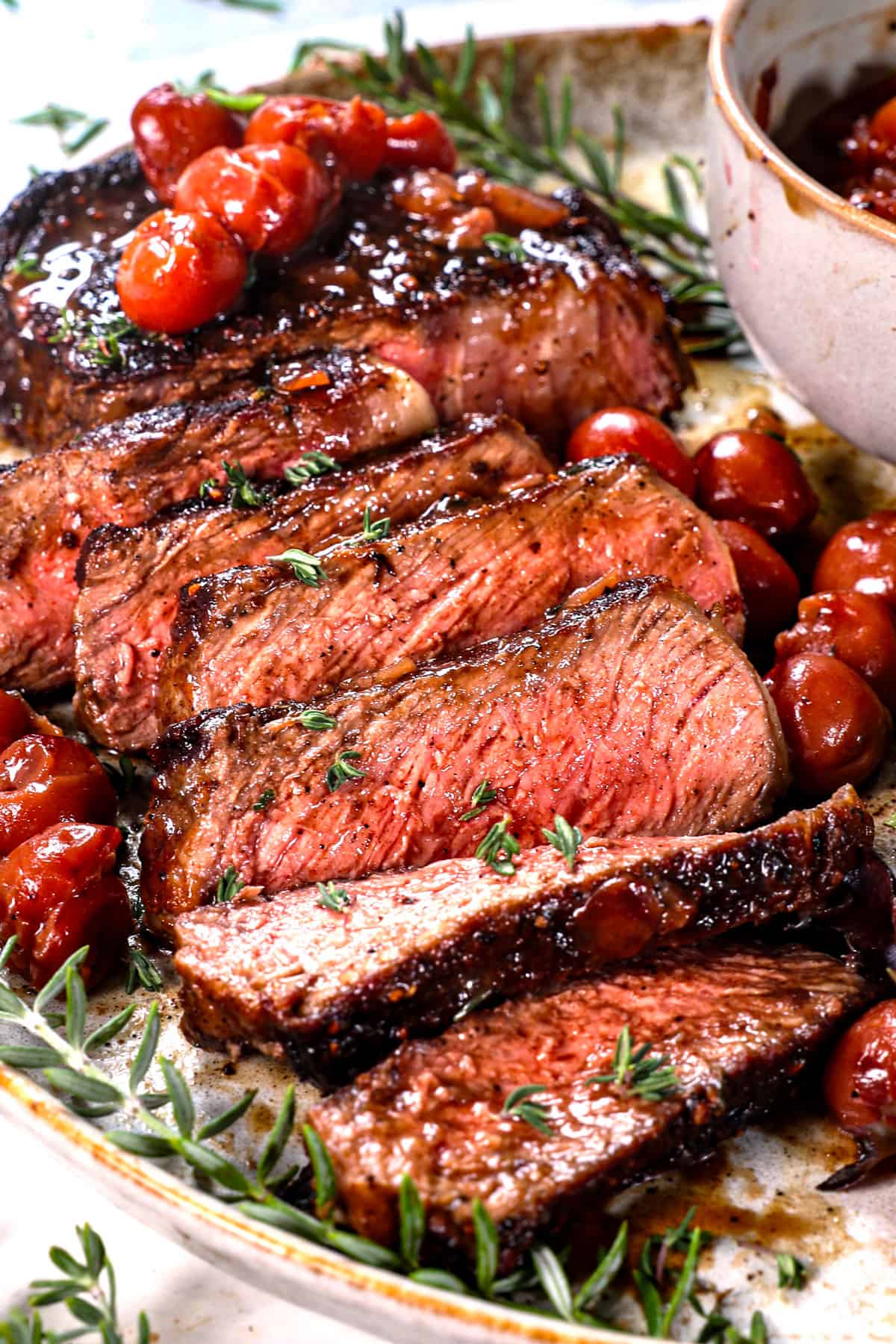
WANT TO TRY THIS Ribeye Steak RECIPE?
PIN IT to your recipe BOARD TO SAVE FOR LATER!
FIND ME ON PINTEREST FOR MORE GREAT RECIPES! I AM ALWAYS PINNING :)!
©Carlsbad Cravings by CarlsbadCravings.com
Tools Used in This Recipe
See Favorite Tools
Ribeye Steak Recipe
Save This Recipe To Your Recipe Box
You can now create an account on our site and save your favorite recipes all in one place!
Ingredients
Ribeye Steaks
- 2 boneless ribeye steaks, 1 to 2” thick
- 2 teaspoons kosher salt (NOT table salt)
- 1 teaspoon freshly cracked pepper
- 1/4 tsp EACH garlic powder, paprika (or more to taste)
- 2 tablespoon vegetable, canola, or grapeseed oil (a high smoking point oil), divided
- 3 tablespoons unsalted butter
- 5 sprigs of rosemary
- 2 sprigs of thyme
- 1 bulb garlic, halved horizontally
Tart Cherry Balsamic Sauce:
- 1 15 oz. can tart cherries, juices separated
- 2/3 cup low sodium chicken broth
- 1 teaspoon cornstarch
- 1 shallot, minced
- 1 tablespoon honey
- 1 tablespoon Dijon mustard
- 2 teaspoons light brown sugar
- 1 teaspoon balsamic vinegar
- salt and pepper to taste
Instructions
STEAK
- Season: Transfer the steaks to a plate and pat dry with paper towels. Season the steaks on both sides with kosher salt, cracked pepper, garlic powder, and paprika, and press it into the steaks (press, don’t rub).
- Rest: Time permitting, refrigerate uncovered for 4 to 48 hours to dry brine. If you don’t have time, let the steaks rest at room temperature for one hour with the seasoning before cooking.
- Bring to Room Temperature: If dry brining, remove the steaks from the refrigerator 60 minutes before cooking to bring them to room temperature.
- Sear: Heat a CAST IRON SKILLET over high heat until smoking. Add one tablespoon of oil and swirl to coat the pan. Reduce heat to medium-high and add the steaks. Cook for 3 minutes without moving (SET TIMER). At 3 minutes, check for a deeply golden sear, and flip or cook for one more minute.
- Add the Aromatics. Flip the steak over, and add the garlic (cut side down), herbs, and one tablespoon of oil to the pan. Sear for three additional minutes, then sear the sides of the steak for about 30 seconds each.
- Baste with Butter: Reduce the heat to medium-low and add the butter. Baste the steaks for one minute, tilting the pan as needed to spoon the butter over the steaks.
- Check the internal temperature: Check the temperature using a meat thermometer inserted into the thickest part of the steaks. You want the temperature to register 5°F lower than the desired doneness (steaks will continue to cook after removing from the skillet). Final desired doneness temperatures: Medium Rare: 130°-140°, Medium: 140°-145°, Medium Well: 150°-160°. Continue to cook and baste with butter until the steak reaches your desired temperature.
- Rest: Transfer the steaks to a plate or cutting board and baste one more time, then loosely tent with foil. Allow them to rest for 10 minutes before slicing against the grain. Meanwhile, make the Tart Cherry Sauce:
Tart Cherry Balsamic Sauce:
- Cherry Slurry: Add one tablespoon of cherry juice to a small bowl. Whisk in the chicken broth and cornstarch and set aside (“cherry juice slurry”).
- Sauté Shallots: Drain all but two tablespoons of butter/drippings from the pan, but leave the garlic and herbs. Add the shallot and sauté until softened, about 3-5 minutes.
- Reduce: Stir in the cherry juice slurry and simmer until reduced and thickened, 2-3 minutes, scraping up the brown bits on the bottom of the pan.
- Add Cherries: Stir in the cherries, honey, mustard, brown sugar, and balsamic. Gently simmer until warmed through. Season, to taste, with honey/brown sugar for sweeter or balsamic for tangier. Season with salt and pepper. Serve over the ribeye steaks.

Did You Make This Recipe?
Tag @CarlsbadCravings and Use #CarlsbadCravngs
Leave a Review, I Always Love Hearing From You!








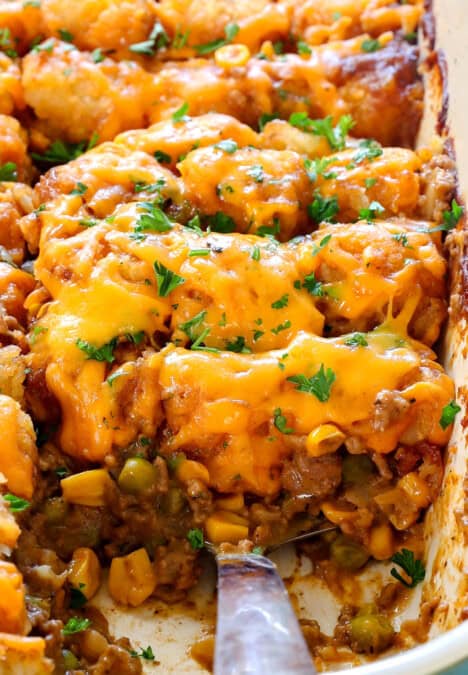
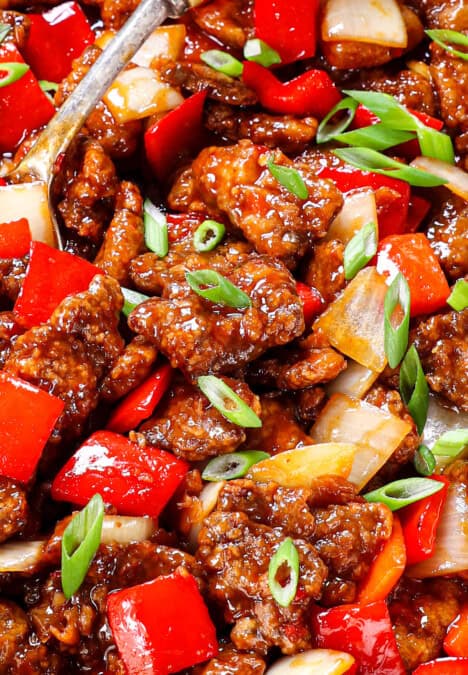


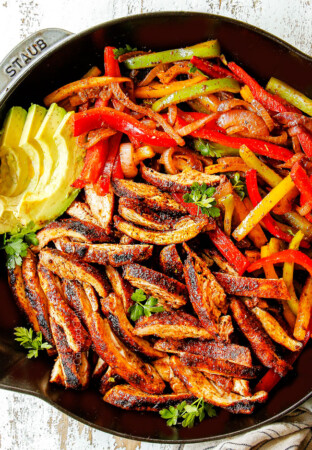

















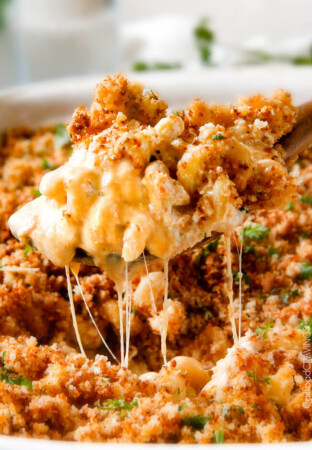


leave a review